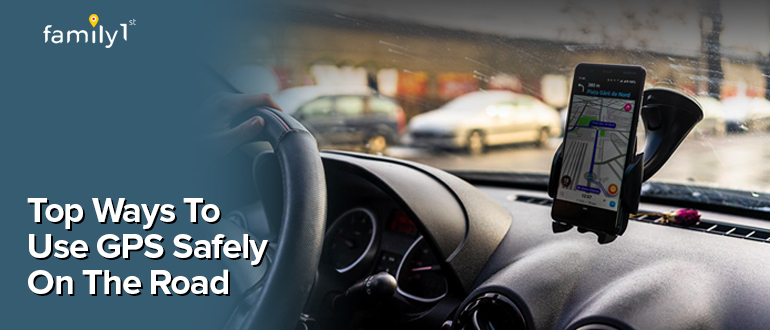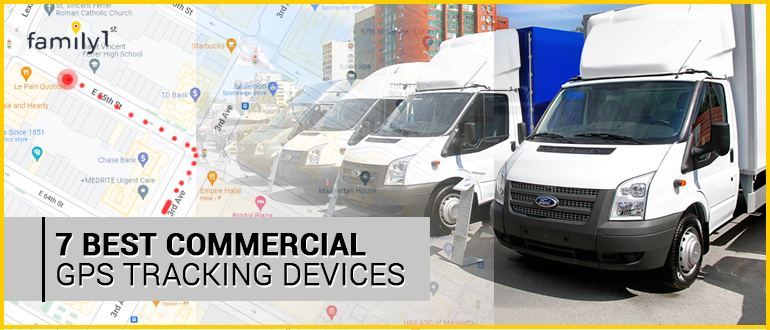Key Takeaways:
- Set up and position your GPS properly to ensure easy visibility and avoid distractions while driving.
- Use voice-guided directions instead of looking at the screen to stay focused and reduce the risk of accidents.
- Limit distractions like background noise and unnecessary conversations so you can clearly hear important GPS alerts.
- Use the Family1st GPS Tracker for real-time tracking and geo-fencing alerts to ensure a safer and more secure driving experience.
GPS helps drivers find their way, avoid traffic, and reach destinations faster. But using GPS the wrong way can cause distractions and accidents.
Safe GPS use keeps your focus on the road while still guiding you to your destination. Simple steps like setting it up before driving and using voice commands make a big difference.
Table of Contents
7 Ways to Use GPS Safely on the Road
Using GPS while driving helps you find the best route, avoid traffic, and reach your destination faster. But if not used properly, it can be distracting and dangerous. To stay safe on the road, follow these simple steps to use your GPS the right way.
1. Set Up Your GPS Before You Start Driving
Before you even start your car, take a few minutes to set up your GPS. This helps you stay focused on the road instead of fumbling with your device while driving.
- Enter your destination first – Type in your location and check the route before you go. This way, you’ll know what to expect.
- Review the directions – Look at the key points of your journey, like major turns or highways. This reduces the need to keep checking the screen.
- Secure your GPS in place – Mount your GPS properly so you can glance at it easily without taking your eyes off the road.
2. Position Your GPS for Easy Viewing
Where you place your GPS makes a big difference in how safely you can use it. The goal is to keep your focus on the road while still being able to see directions.
- Mount it at eye level – Place your GPS on the dashboard or windshield where you can see it quickly.
- Avoid placing it too low – Looking down at your lap or the passenger seat to check directions is risky and distracting.
- Keep the road in sight – Your GPS should never block your view of traffic, signals, or pedestrians.
3. Plan Rest Stops Along the Way
Long drives can be tiring, and fatigue is a major cause of accidents. Use your GPS to plan when and where to take breaks.
- Find rest stops ahead of time – Look up places where you can stop for food, fuel, or a quick stretch.
- Listen to your GPS alerts – Some GPS apps suggest breaks if they detect long hours of driving. Pay attention and take them when needed.
- Don’t push yourself – If you feel tired, pull over and take a break instead of forcing yourself to keep driving.
4. Limit How Much You Interact With GPS While Driving
The less you touch your GPS while driving, the safer you’ll be. Make adjustments before you start and avoid distractions.
- Change settings before the trip – If you need to avoid tolls, highways, or set up other preferences, do it before you hit the road.
- Don’t type or text – Never enter an address or search for places while driving. If needed, pull over safely before making changes.
- Keep your hands on the wheel – The more you focus on driving, the safer you and everyone around you will be.
5. Use Voice-Guided Directions
Listening to directions instead of looking at the screen keeps your eyes on the road. Most GPS apps have a voice guidance option—use it!
- Follow spoken instructions – Let the GPS tell you when to turn so you don’t have to check the map often.
- Stay focused on driving – With voice commands, you can concentrate on the road instead of reading a small screen.
- Reduce stress – Knowing you’ll hear the next step in advance makes your trip smoother and safer.
6. Keep Background Noise Under Control
Loud music or talking can make it hard to hear important GPS instructions. Make sure the sound inside your car doesn’t interfere with navigation.
- Lower the volume when needed – Keep music and other sounds at a level where you can still hear the GPS clearly.
- Don’t let conversations distract you – Chatting with passengers is fine, but don’t let it take your focus off the road.
- Pay attention to alerts – Important GPS notifications like lane changes or traffic updates can help you avoid trouble.
7. Ask a Passenger for Help When Possible
If someone is traveling with you, let them handle the GPS adjustments. This allows you to drive safely while they manage the directions.
- Let your passenger check directions – They can confirm upcoming turns or reroute if needed.
- Ask them to look up stops – If you need gas or food, have your passenger search for nearby options.
- Pull over if you’re alone – If you have no one to help, stop in a safe place before making any GPS changes.
Why Do You Need GPS While Driving?
Helps You Find the Best Route
GPS provides step-by-step directions, so you don’t have to worry about memorizing roads. It ensures you stay on track and avoid unnecessary detours.
Saves Time with Traffic Updates
GPS gives real-time traffic updates and suggests faster routes to avoid delays. It helps you navigate around roadblocks, accidents, or construction zones.
Reduces the Stress of Driving in New Places
When driving in an unfamiliar area, GPS makes navigation easy and stress-free. It guides you through unknown streets, so you never feel lost.
Provides Estimated Arrival Time (ETA)
GPS calculates how long it will take to reach your destination based on current traffic. This helps you plan better and stay on schedule.
Assists in Finding Nearby Places
GPS helps locate gas stations, restaurants, hotels, and other essential stops on your route. This makes road trips and daily drives more convenient.
Enhances Road Safety
By giving clear voice-guided directions, GPS allows you to keep your focus on the road. It minimizes distractions and reduces the risk of accidents.
Helps in Emergency Situations
GPS can provide your exact location to emergency services if you need help. It ensures quick assistance during accidents or breakdowns.
Saves Fuel and Money
By guiding you on the shortest and most efficient route, GPS reduces unnecessary driving. This helps you save fuel and lower travel costs.
Works in All Weather Conditions
Unlike physical maps, GPS functions in rain, fog, or snow without any issues. It ensures you stay on the right path, no matter the weather.
Keeps You Updated on Speed Limits
Many GPS apps display speed limits, helping you avoid speeding tickets. This ensures you drive safely and stay within legal limits.
Family1st: Your safety is our priority
![]()
Family1st GPS Tracker helps drivers stay on the right path with real-time location updates. It ensures you never get lost, making every journey smooth and stress-free.
With geo-fencing alerts, drivers can set safe zones and get instant notifications if a vehicle enters or leaves a specific area. This feature adds an extra layer of security, especially for families and fleet owners.
The long battery life means you don’t have to worry about frequent charging during long trips. Its compact design allows easy and discreet placement, ensuring reliable tracking without any distractions.
Conclusion
Using GPS safely while driving helps you stay on the right path without distractions. By setting it up before you drive and using voice guidance, you can focus on the road and reach your destination safely.
With the Family1st GPS Tracker, you get real-time tracking, geo-fencing alerts, and long battery life for a hassle-free experience. Whether for personal use or family safety, this tracker ensures peace of mind every time you hit the road.









Next
Previous